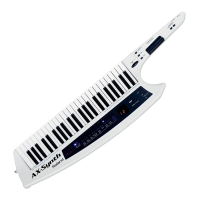
Do you have a question about the Roland AX-Synth and is the answer not in the manual?
| Polyphony | 128 voices |
|---|---|
| Type | Shoulder Synthesizer |
| Effects | Reverb, Chorus, Flanger, Phaser, Delay, Distortion, EQ |
| Power Supply | Rechargeable Ni-MH battery or AC adapter |
| MIDI | In, Out |
| Weight | 3.9 kg (8 lbs. 10 oz.) |
| Controllers | D-Beam Controller, Ribbon Controller, Modulation Bar |
| Connectors | Output (L/Mono, R), Phone jack, MIDI (In, Out), USB |
| Keyboard | 49 keys (velocity sensitive) |
Explains warning and caution symbols used in safety instructions.
Explains general warning, forbidden, and mandatory action symbols.
Discusses power sources, AC adapter, battery usage, and safe operation.
Covers suitable locations, environmental conditions, and avoiding interference.
Detailed safety guidelines for battery installation, usage, and handling precautions.
Details the ergonomic control layout on the unit's neck and programming features.
Step-by-step guide for connecting the AC adapter and installing batteries.
Procedures for safely turning on and off the AX-Synth and connected devices.
How to select Tones, including regular, SuperNATURAL, and SPECIAL types.
Assigning and recalling favorite Tones using FAVORITE banks.
General considerations and connection steps for using the USB port with a computer.
Guide to diagnosing and resolving common operational problems.